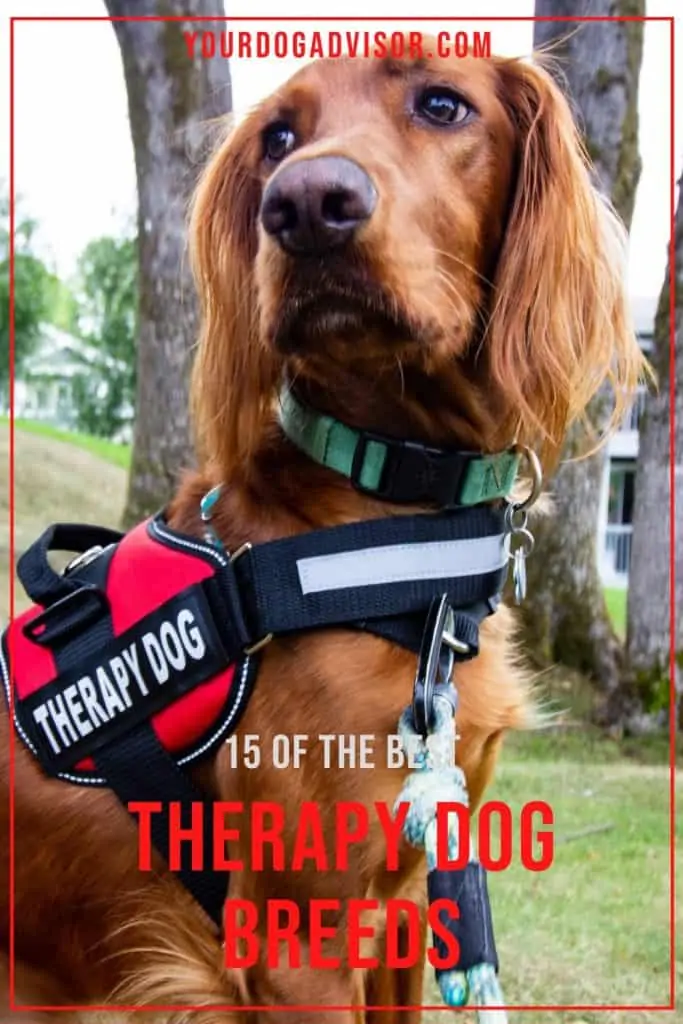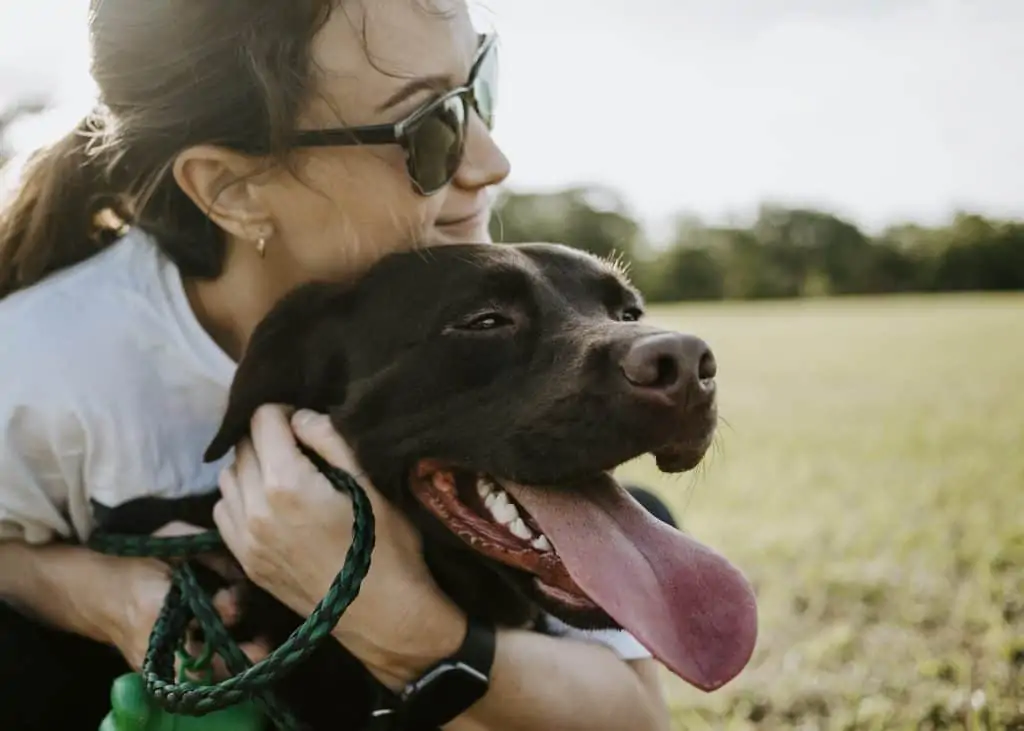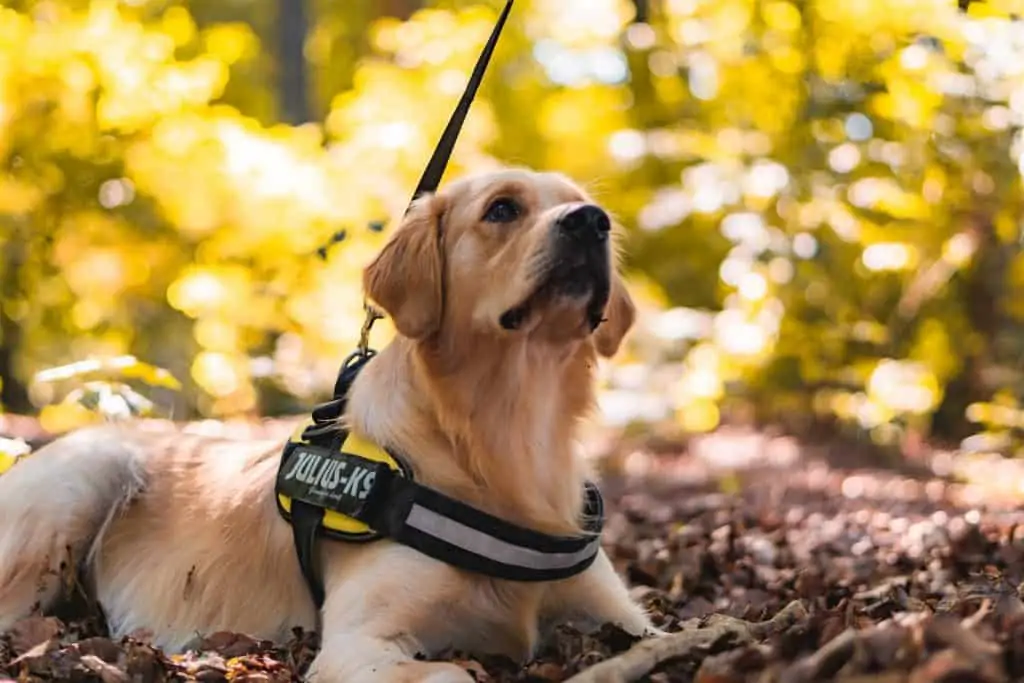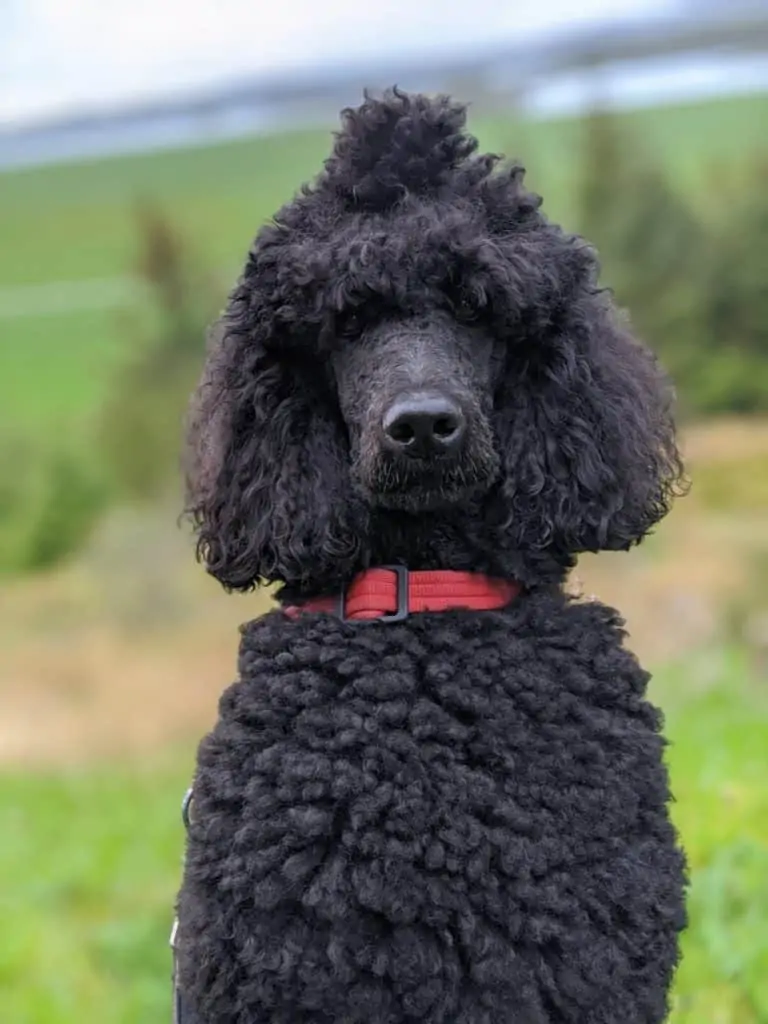Are you looking for a therapy dog? You’re not alone. It’s estimated that there are over 500,000 therapy dogs currently at work in the United States.
Therapy dogs are good for more than just our mental health. Therapy dogs can help enhance heart health, assist adults and children with autism, reduce stress, lower blood pressure, aid in memory loss and help trauma survivors heal.
The more we learn about the amazing benefits of therapy animals, the more we come to appreciate them.
But what exactly is a therapy dog, and what are some of the best therapy dog breeds out there?
We’re about to find out!
Contents
What Is A Therapy Dog?
A Therapy dog can help reduce stress, pain, anxiety and fear in those who are struggling.
There are three common types of support dogs you may or may not be aware of, and all of them serve a different and very important purpose.
These types include:
- Emotional Support Dogs
- Service Dogs/Psychiatric Support Dogs
- And Therapy Dogs
What Is An Emotional Support Dog?
An emotional support dog is considered a pet, not a trained service animal or therapy dog. These dogs are typically prescribed by licensed psychiatrists who recognize that the person in need would benefit from the emotional support and companionship of a furry friend.
Emotional support dogs are somewhat controversial these days, but there is no denying the evidence surrounding the true benefits they bring to those who need their comfort.
Most emotional support dogs can undergo training through specific programs, although it’s important to note that ESAs are not allotted the same accommodations as service dogs or psychiatric support dogs, and many airlines are no longer required by law to allow them onto an airplane free of charge.
What Is A Service Dog/Psychiatric Support Dog?
A service dog or psychiatric support dog (also known as a psychiatric service dog) is a dog that has been professionally trained and is certified to help aid in the everyday lives of humans in need.
The most common types of service dogs perform work as guide dogs, dogs for the hearing impared, medical alert dogs, mobility service dogs and more.
To be considered a true service dog, dogs must be professional certified and continually refresh their training and certifications to ensure they are providing the safest and best services to their people as possible.
Service dogs have a number of accommodations that most other dogs do not, allowing them access to any areas their humans have access to by law.
What Is A Therapy Dog?
A therapy dog is a dog that has been specifically trained to visit places like hospitals, nursing homes, retirement homes, and more.
These dogs are trained to be gentle, calm and affectionate around people and most commonly are there to assist people in getting through what would otherwise be a very difficult time.
Many types of therapy dogs can help make hospital stays more bearable for children or adults. They also help comfort victims of violence or trauma when giving testimony during court appearances.
Therapy dogs have even been found to help reduce stress and bring calm and comfort to nursing homes, especially when brought into facilities with those suffering from dementia or Alzheimer’s disease.
Typically, therapy dogs undergo specific training and testing before being certified as official therapy dogs. That said, they still may not have the same legal access to certain areas like their service dog counterparts do.
Of course, we know that all dogs have the ability to make us happy, calm and relaxed, but does that mean every dog can qualify to be a therapy dog?
Not quite.
Keep reading to learn why.
What Makes A Dog A Good Therapy Dog Breed?
The ideal therapy dog will be affectionate, trainable and calm.
While we think all dogs are great, we also know that not all dogs make great therapy dogs. When looking for good therapy dog breeds, you should try and hone in on certain characteristics that often come from particular breeds or mixes. Some of the best therapy dogs are going to be:
Calm Dogs
If you are bringing a dog into a hospital, nursing home or courtroom, it’s important that the dog is calm, mild-mannered and gentle.
A dog that is too energetic, playful or vocal will not make an ideal therapy dog, as these types of traits can actually heighten anxiety and stress as opposed to reduce it.
Intelligent Dogs
An intelligent dog is a must when it comes to a therapy dog, but we’re not just talking about booksmarts. The best therapy dogs are not only mentlly intelligent, but they are emotionally intelligent too.
A good therapy dog should be highly trainable and also be able to tap into the emotional needs of the human they are assisting. This will be key to ensuring they can do their job well.
Sociable Dogs
You’ll also want to look for dogs that are naturally social. A great therapy dog will not be overly excited to meet other dogs or new people, and he will be relaxed and happy in a variety of environments.
Remember, a therapy dog’s purpose is to meet and comfort a variety of people, and he could be introduced to many people in a single day. It will be important that he enjoys people, is confident in greeting new people, and is calm all the while.
Gentle Dogs
An ideal therapy dog will be gentle in everything he does, from greeting a human to taking a treat, to walking alongside the human with a loose leash in a relaxed stride.
Dogs that are excitable or dogs that prefer to play rough may not make ideal therapy dogs, so it’s important to keep this in mind.
Affectionate Dogs
Last but not least, make sure you find a therapy dog that is affectionate. This is one trait that can be difficult to train into a dog, as many dogs either enjoy being handled or they do not. The best therapy dogs will enjoy being cuddled, loved on, pet, and handled by a number of people.
15 Of The Best Therapy Dog Breeds, According To Experts
Labs and Golden Retrievers have long been some of the world’s top dogs when it comes to service and therapy work.
To be honest, most breeds have the potential to make a good therapy dog so long as the dogs have the right tools, foundation and trainer at an early age.
Of course, there are some breeds that are just built for therapy dog work, and those breeds include:
- The Labrador Retriever
- The Golden Retriever
- The Labradoodle
- The Goldendoodle
- The Poodle
- The Maltese
- The Maltipoo
- The French Bulldog
- The Pembroke Welsh Corgi
- The Cavalier King Charles
- The Yorkshire Terrier
- The Whippet
- The Pomeranian
- The Beagle
- The Border Collie
But what makes these therapy dogs so good at what they do? Let’s find out!
1. Labrador Retriever
Labs are not only one of the top rated therapy dogs, but they are also considered America’s most popular purebred.
Height: 21.5 to 24.5 Inches
Weight: 55 to 80 Pounds
Lifespan: 10 to 12 Years
Hypoallergenic: No
Overview:
As some of the most intelligent dogs in the world and certainly one of the most popular, it’s no surprise that the Labrador Retriever is one of the top choices when it comes to therapy dog work. Of course, Labs aren’t only ideal as therapy dogs. They are also some of the most coveted canines when it comes to Emotional Support Animals and Service Dogs.
Labrador Retrievers are highly trainable, eager to please and social. When raised correctly, they are gentle and affectionate towards people of all ages and even other animals.
However, Labradors can be high-energy dogs, especially when they are younger. It should also be noted that Labrador Retrievers are a shedding breed, so they won’t be the best therapy dogs in areas where hypoallergenic dogs are required.
2. The Golden Retriever
Like Labs, Golden Retrievers are some of the world’s most popular and devoted service companions.
Height: 21 to 24 Inches
Weight: 55 to 75 Pounds
Lifespan: 10 to 12 Years
Hypoallergenic: No
Overview:
Similar to the Labrador, the Golden Retriever is another top dog when it comes to therapy dog work. Golden Retrievers are friendly, gentle, intelligent and social. They enjoy children and seniors, and anyone really.
A properly trained and socialized Golden Retriever will know no strangers, and he will enjoy meeting new people and exploring new environments.
Of course, like the Lab, the Golden Retriever is a shedding dog. He has a dense, double layered coat that could exacerbate allergies in some individuals.
Golden Retriever dogs are also quite energetic in their early years, and they will require plenty of exercise and mental stimulation to help ensure they are calm, relaxed and on their best behavior when at work as a therapy dog.
3. The Labradoodle
Labradoodles were actually created to work as service and therapy dogs for those who suffer from allergies.
Height: 18 to 24 Inches
Weight: 30 to 90 Pounds
Lifespan: 10 to 15 Years
Hypoallergenic: Yes
Overview:
We have to admit we love the Labradoodle. This is a curly haired mix between the Lab and the Poodle, and he is currently one of the world’s most popular hybrids.
Not only is the Labradoodle an incredibly intelligent and affectionate dog, he makes a wonderful therapy dog. His hypoallergenic coat makes him ideal for those who suffer from allergies and his trainable, sweet nature makes him the perfect therapy dog to enter hospitals, senior centers and court rooms.
However, Labradoodles can be very high energy and require a consistent owner and trainer if he is working towards therapy dog work. He may also be best suited for therapy dog work once he is over the age of two.
4. The Goldendoodle
Goldendoodles are quickly becoming some of the most sought after crossbreeds in the United States for therapy work.
Height: 17 to 24 Inches
Weight: 30 to 90 Pounds
Lifespan: 10 to 15 Years
Overview:
Like the Labradoodle, the Goldendoodle is another hybrid designed to create a less allergy-inducing Golden Retriever-like dog.
Goldendoodle dogs are eager to please, easy to train and family oriented. They get along well with children and other pets and make great therapy dogs when properly trained and socialized.
Like all dogs, Goldendoodle dogs are going to need plenty of early training and socialization. Of course, this will be even more important if you’re looking to obtain a Goldendoodle for therapy dog work.
5. The Poodle
Poodles can make wonderful therapy dogs as they are intelligent, hypoallergenic, and even come in three size varieties.
Height: 9 to 15+ Inches
Weight: 6 to 70 Pounds
Lifespan: 12 to 18 Years
Hypoallergenic: Yes
Overview:
The purebred Poodle comes in three size varieties and has long been considered one of the world’s top therapy dogs. A natural performer, Poodles have enjoyed a long history working as circus dogs, street performers, water retrievers and more.
These hardy, healthy dogs are long lived and friendly, and they are highly trainable. However, they are some of the world’s most intelligent dogs and can be prone to struggling with destructive behaviors if their mental stimulation and exercise needs are not met.
The good news is that if you are looking to get a Poodle for therapy dog work, he’ll constantly be having his needs met during routine training. Poodles are also very emotionally intelligent, which is another trait that can help them when it comes to therapy dog work.
6. The Maltese
The Maltese is a bred companion dog. He is also hypoallergenic, affectionate and devoted.
Height: 7 to 12 Inches
Weight: 4 to 8 Pounds
Lifespan: 12 to 15 Years
Hypoallergenic: Yes
Overview:
While many therapy dogs we think of tend to be larger breeds, there are also smaller dogs that make great therapy dog breeds. One such dog is the sweet and adorable Maltese.
Hailing from the island of Malta, the Maltese is a little white dog with a big heart of gold. Bred specifically for companionship, the Maltese makes a great therapy dog typically for adults and older children.
This is a dog that is a lap dog to the fullest, and can help alleviate stress and anxiety simply by curling up in someone’s arms. Maltese dogs have enjoyed therapy dog work in hospitals, court rooms, senior centers and more.
7. The Maltipoo
The Maltipoo brings the added bonus of a sweet natured Maltese and a very clever Poodle to the Therapy dog scene.
Height: 8 to 14 Inches
Weight: 5 to 20 Pounds
Lifespan: 12 to 15 Years
Hypoallergenic: Yes
Overview:
Maltipoos are increasing in popularity, but they make especially good therapy dogs because they combine the clever Poodle with the sweet-natured Maltese. A hybrid dog with a bit more energy and pizzas, the Maltipoo makes a wonderful therapy dog.
He is hypoallergenic, making him an ideal therapy dog for anyone who suffers from allergies. However, smaller dogs like the Maltipoo may be more difficult to train in some aspects, especially when it comes to potty training.
The good news is that Maltipoo dogs are friendly, affectionate and emotionally intelligent. They do best with positive reinforcement training techniques and, with the right owner and trainer, are quick to learn.
8. The French Bulldog
Frenchies make surprisingly sweet and devoted little therapy dogs.
Height: 11 to 12 Inches
Weight: 16 to 25 Pounds
Lifespan: 10 to 14 Years
Hypoallergenic: No
Overview:
Who would have thought that a French Bulldog would make such a good therapy dog? Well, the secret is out! Frenchies are sweet, people-oriented, affectionate and just fun enough to bring a smile to your face without being overly energetic.
French Bulldogs are also a smaller and more compact version of a therapy dog, but they are also sturdy and less fragile than smaller pups like the Maltese.
The Frenchie is not hypoallergenic, however, and he can suffer from a few major health issues any owner should be aware of.
That said, with plenty of training, routine exercise, mental stimulation and socialization, you’ll likely find that the French Bulldog makes a wonderful therapy dog option for a variety of situations.
9. The Pembroke Welsh Corgi
Corgis are intelligent, friendly and people-oriented. These are all traits that help to make a wonderful therapy dog.
Height: 10 to 12 Inches
Weight: 23 to 28 Pounds
Lifespan: 12 to 15 Years
Hypoallergenic: No
Overview:
The Pembroke Welsh Corgi has long been considered a royal dog. Adored by the queen, the Corgi is a small yet energetic little herding dog bred for intelligence, stamina and devotion. These traits, when harnessed correctly, make the Corgi an ideal and cheerful therapy dog.
Corgis do well with children and other pets, though they do have herding instincts. A Corgi utilized for therapy dog work will need to undergo some serious training in order to qualify for certification. But, for the most part, the Corgi is eager to please and quick to learn.
Just be sure to stick with positive reinforcement training techniques like treats, praise and patience.
10. The Cavalier King Charles Spaniel
Cavaliers are wonderful and affectionate therapy dogs. Infact, they are famous for their “Cavalier hugs”!
Height: 12 to 13 Inches
Weight: 13 to 28 Pounds
Lifespan: 9 to 14 Years
Hypoallergenic: No
Overview:
Cavalier King Charles Spaniel dogs are the ideal therapy dog for anyone needing a bit of extra affection. This beautiful dog is famous for what is known as his “Cavalier hug” which is a move he makes to snuggle in as close as he can.
The Cavalier King Charles Spaniel is an emotionally intelligent dog that is a great therapy dog for hospital work. His calm and gentle nature also makes him a great candidate for visiting nursing homes or retirement facilities.
The only downside to the Cavalier is that he does shed, though this shouldn’t be a problem if you keep him on a quality diet and keep up with grooming, as well as ensure the places you are visiting do not prohibit dogs that are not specifically hypoallergenic.
11. The Yorkshire Terrier
The Yorkie is a pocket-sized pup that is the perfect therapy dog for older folks looking for a cuddly companion.
Height: 8 to 9 Inches
Weight: Under 7 Pounds
Lifespan: 13 to 16 Years
Hypoallergenic: Yes
Overview:
Yorkshire Terriers are not some of the most well-known therapy dogs, but they can do well to relax adults and calm seniores. They also make wonderful comfort and support animals.
The Yorkie is quite small, however, and won’t be the ideal therapy dog for young children unless children are especially gentle. That said, when trained and socialized properly at a young age, many Yorkies can grow up to be calm, devoted, affectionate and successful therapy dogs for the right programs.
12. The Whippet
Many people don’t realize what incredible, affectionate and devoted therapy dogs Whippets can make.
Height: 19 to 22 Inches
Weight: 18 to 34 Pounds
Lifespan: 12 to 15 Years
Hypoallergenic: No
Overview:
One of our top traits for the best therapy dog breeds is a calm disposition. For this reason, you may be surprised to find the Whippet on our list. While Whippet dogs are known for their incredible bursts of speed, the truth is that these dogs are actually quite docile and calm.
They are mild-mannered, gentle and highly affectionate, and they are eager to please and quick to learn. They also have a number of silly quirks that can easily bring a smile to people’s faces.
Whippet dogs should be walked on a leash no matter how well trained they are, however. While they are calm dogs, they are capable of explosive speeds and tend to have a high prey drive for smaller animals.
13. The Pomeranian
Pomeranians are the ideal therapy dog for those looking for a small, sweet and teddy bear-like canine.
Height: 7 to 12 Inches
Weight: 3 to 14 Pounds
Lifespan: 12 to 16 Years
Hypoallergenic: No
Overview:
The teddy bear has long been considered the ultimate comfort toy for youngsters, so what would make a better therapy dog than a living teddy bear lookalike? The Pomeranian is one such dog, with an especially fluffy coat and spirited, affectionate disposition.
Pomeranians can be quite small, however, and may not make the ideal therapy dog for very young children if they are especially tiny. That said, some Pomeranians are more sturdy than others and they get along well with people of all ages and even other pets.
The little Pomerainian is very people oriented and is a devoted and lively little companion dog. He becomes very bonded to his people and is emotionally intune, making him an ideal support and comfort dog for those in need.
14. The Beagle
Beagles can make ideal therapy dogs for younger people, as they do especially well with children.
Height: 13 to 15 Inches
Weight: 18 to 30 Pounds
Lifespan: 12 to 15 Years
Hypoallergenic: No
Overview:
The Beagle is one of the world’s most popular dogs and has been made famous in a multitude of movies, commercials and shows. Why? Because Beagles are super intelligent and trainable!
This of course makes them wonderful therapy dog options for anyone looking to obtain a dog that is trainable. Best of all, Beagles are kid-oriented. They can be some of the top therapy dog options for children as they are not too small but not too big, and they are playful, friendly and affectionate.
Beagles are shedding dogs, though their coats are short and smooth and shouldn’t shed too heavily outside of shedding season.That said, they can still cause allergies in some sensitive people, so keep that in mind.
15. The Border Collie
Border Collies are highly intelligent and can make excellent therapy dogs for a multitude of situations.
Height: 18 to 22 Inches
Weight: 30 to 40 Pounds
Lifespan: 10 to 17 Years
Hypoallergenic: No
Overview:
Last but certainly not least we have the Border Collie. Considered one of the world’s most intelligent purebred dogs, it’s no wonder the Border Collie is on our list of best therapy dog breeds!
Border Collies are bred herding dogs, and they are happiest when they have a job to do. This is great news if you’re wanting to employ your Border Collie as a therapy dog, as this canine will be eager to please you and quick to learn and take on any responsibilities given to him.
That said, Border Collies are not hypoallergenic and they can be quite energetic. They need plenty of mental stimulation, training and exercise in order to stay happy and healthy, and in order to ensure they are the best therapy dogs they can be.
What You Should Know About Raising A Therapy Dog
Therapy dogs are considered different from service dogs, but it’s still important to ensure you train and raise these special dogs right.
Therapy dogs do not need to be professionally trained, but in order to gain access to therapy work with your dog, (for example, visiting hospitals), you’ll likely need to get a certification. You can have your dog certified through the American Kennel Club’s Canine Good Citizen (CGC) test.
This test will quiz your dog on skills that make great therapy dogs, including basic cues like sit, down, heel, stay, leave it, drop it, etc, but also more complicated tasks that are more therapy-based.
If you do wish to have your dog professionally trained before taking the CGC test, you can always contact your local AKC organization for references.
Of course, raising a good therapy dog is more than just raising a dog that’s a great test taker.
In order to qualify as a therapy dog, your dog must also be over one year of age, been certified (in most regions) through the CGC exam, and have a good partner.
That’s right – we’re talking about YOU.
A therapy dog is only one half of a team, and you make up that other half. At the end of the day, you’ll need to decide not only if therapy work is right for your four-legged friend, but also if it’s right for you.
There are pros and cons to working with a therapy dog, and while this position can be incredibly rewarding, it can also be emotionally draining.
Be aware of what you are getting into by ensuring you do plenty of research. It’s also important to make sure your dog is the ideal candidate for therapy dog work.
So, if you don’t have a dog yet and are looking for the perfect therapy dog, we certainly would recommend one of our 15 listed dog breeds above.
And remember, you’re a major part of a two-player team when it comes to your therapy dog’s work and success. Be sure to do your research, be committed, and enjoy the journey.


Jen Jones is a professional dog trainer and behavior specialist with more than 25 years of experience. As the founder of ‘Your Dog Advisor’ and the ‘Canine Connection’ rehabilitation center, she applies a holistic, empathetic approach, aiming to address root causes rather than merely treating symptoms.
Well known for her intuitive and compassionate approach, Jen adopts scientifically-proven, reward-based methods, encouraging positive reinforcement over punishment. Jen specializes in obedience training, behavior modification, and puppy socialization. Her innovative methods, particularly in addressing anxiety and aggression issues, have been widely recognized. Jen has worked with many of the world’s leading dog behaviorists and in her free time volunteers with local animal shelters and rescue groups.


















